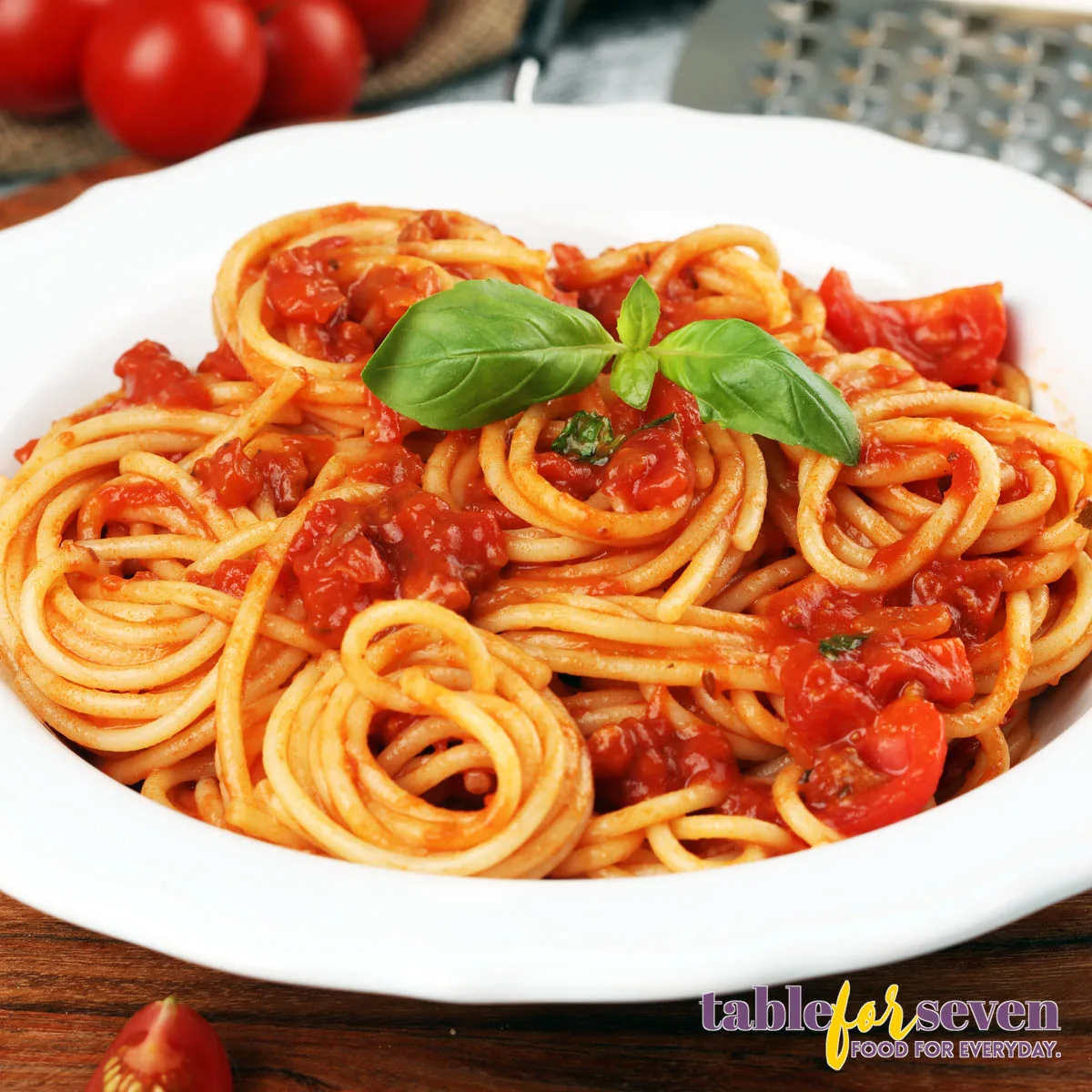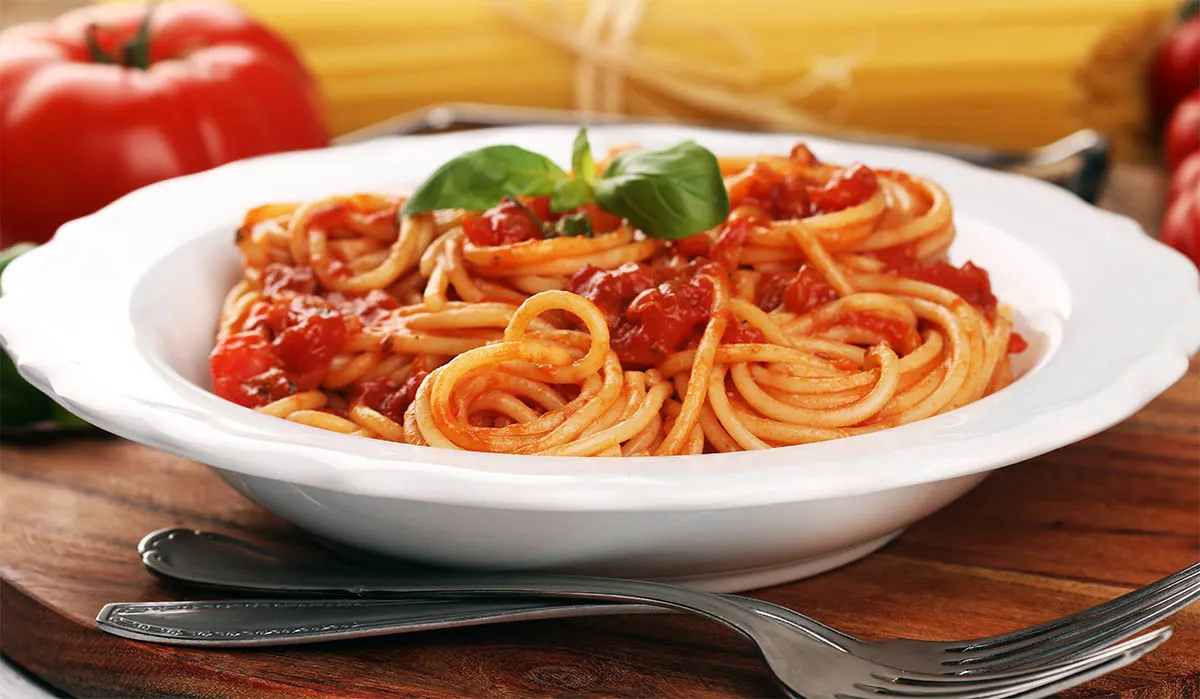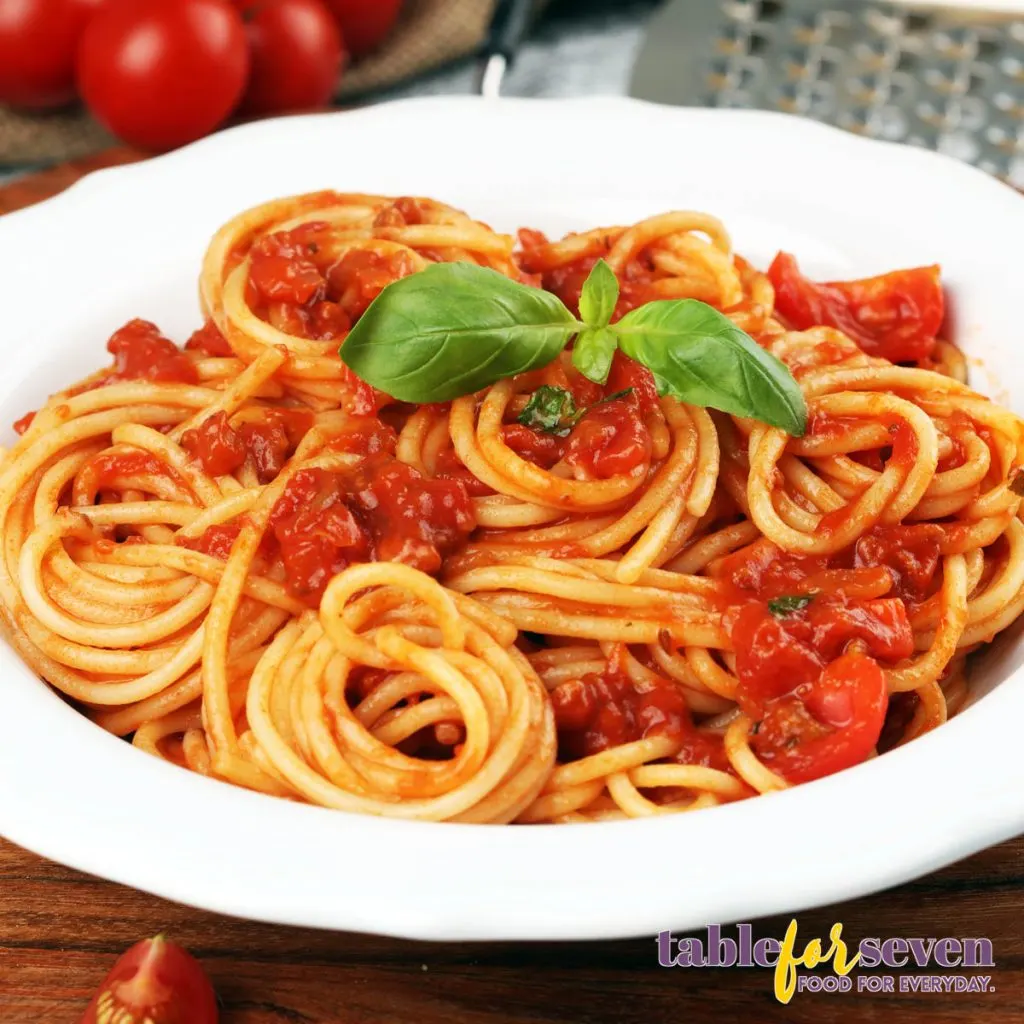This simple recipe for Cheesecake Factory pasta Napoletana is ready in only 10 minutes and is created with our super quick Italian homestyle Napoli sauce. All you need to do is add your preferred pasta and some parmesan, and you’re good to go!

Why You’ll Love This Recipe
Cheesecake Factory Pasta Napoletana Meal is great to have in your arsenal if you’re searching for a super quick, extremely simple supper recipe; you can put it all together in just 10 minutes!
The classic tomato-based Napoli sauce requires only four basic components (which you can use for so much more than just pasta). Below you’ll find a ton of suggestions on how to adjust the recipe to your preferences and the ingredients you plan to use.
Make enough to enjoy for lunch the next day or to store in the freezer for a rainy day.
What Is Napoli Sauce?
Salsa di Pomodoro alla Napoletana, or simply “la salsa,” is the Italian name for Napoli sauce (the sauce). Napoletana sauce, Italian tomato sauce, and Neapolitan sauce are all English names for a type of sauce that is essentially the same as marinara.
The term “Naples” refers to the fact that this vegetarian pasta sauce was first created in that Italian city. However, there are a lot of variations in the approach, depending on factors like geographical preference and individual taste.
This recipe has been made as straightforwardly as possible so that you can follow it exactly or make adjustments to suit your tastes.
Cheesecake Factory Pasta Napoletana Ingredients
- Passata. For optimal flavor, passata should be served at room temperature. For a meatier sauce, try using a combination of passata and tomato puree, or even fresh chopped tomatoes. You may also use fresh tomatoes, tomato paste, or canned tomatoes in the san Marzano style (we like the multi-brand).
- Garlic. The finest flavor comes from garlic which is both fresh and freshly sliced. For a time saver, use minced garlic.
- Olive Oil. Although extra virgin olive oil is highly recommended, feel free to use any oil you choose.
- Grated Parmesan Cheese. Alternatively, you may add shredded cheese, a different type of cheese, or even some pecorino romano for a sharper cheesy bite.
- Pasta. Spaghetti and bucatini are our go-to for this sauce, but feel free to use it on your preferred type of pasta.
What Is Passata?
Passata, an Italian sauce, is created from raw tomatoes with the skin and seeds removed. It tastes strongly of fresh tomatoes and is silky and saucy in texture. When tomatoes are boiled down until very thick and concentrated, the result is tomato paste, which is quite different.
Passata is great for rapid pasta sauces like Napoli sauce since the time-consuming step of preparing the tomatoes has already been completed.
Can I Use Fresh Tomatoes To Make Pasta Napoletana?
Yes, you certainly can; in fact, doing so is a fantastic way to put overripe or soft tomatoes to good use. They should be roughly chopped before being added to the pan. If you like a smoother, more passata-like consistency, you may remove the skin and the seeds before cooking (or leave them in to save on time). The sauce needs extra time on the stovetop to allow the water content to evaporate.

How To Make Cheesecake Factory Pasta Napoletana
- Cook the pasta according to the package guidelines until it is al dente. Once ready, drain it immediately.
- While the pasta cooks, combine the passata, olive oil, and garlic in a small saucepan and bring to a boil, stirring regularly, before removing it from the heat.
- Place the cooked pasta in a large mixing basin and generously sprinkle it with Napoli sauce. Transfer pasta to serving plates or bowls, cover with Napoli sauce, and sprinkle with Parmesan cheese.
- Garnish with sea salt and crushed black pepper, as well as fresh parsley or basil leaves, if desired!
What To Serve With Pasta Napoletana?
- Roasted Cherry Tomatoes
- Air Fryer Cauliflower
- Vegan Sweet Potato, Lima Bean Salad
- Caprese Salad
- Sauteed Zucchini with Herbed Parmesan
- Roasted Broccolini Salad with Crispy White Beans
- Avocado Fries
- Zucchini Fries
- Maple Mustard Brussels Sprouts
- Focaccia Genovese
- Creamy Vegan Coleslaw
- Bacon Wrapped Green Beans
For What Else Might I Use Napoli Sauce?
This tomato sauce may be used in a wide variety of ways. Substitute it for spaghetti or canned tomatoes in red sauces like bolognese, ragu, or pasta amatriciana. Use it as a pizza sauce base, or in baked meals like spaghetti al Forno or moussaka. It works wonderfully as a meatball sauce or as a topping for a parmigiana made with breaded chicken.
Can I Adapt This For Vegetarians And Vegans?
It’s perfectly vegan with the exception of the parmesan cheese; the passata/tomatoes, olive oil, and garlic are the only other ingredients. Make sure the pasta you buy is egg-free by reading the label (this is especially true for “fresh pasta”).
Would It Be Possible To Bottle This Sauce?
Even while it’s possible, we recommend proceeding with care because we usually freeze any leftovers.
Bottle the sauce by letting it cool to room temperature so that it is manageable before transferring it to sterilized glass bottles and sealing them. To boil the bottles, put them in a large, deep saucepan and cover them with water. Do not try to take the bottles from the water while they are still hot; instead, turn off the heat and let them cool down. After they have cooled, towel them thoroughly and keep them in a cold, dry, dark location.
How To Store Pasta Napoletana?
- In The Fridge. When stored in the refrigerator in an airtight container, Napoletana pasta will stay fresh for two to three days (possibly longer, but always use your best judgment). If at all possible, you should keep the pasta and sauce in separate containers so as to prevent the pasta from becoming bloated and soaking up all of the liquid in the sauce.
- In The Freezer. Additionally, this pasta Napoletana sauce freezes nicely; simply keep it in portions to make it simpler to use at a later time, and use it within two to three months for the flavor to be at its peak.
- To Reheat. Put the pasta Napoletana in a pan and cook it up over low to medium heat until it is hot all the way through.
Recipe Variations
- Choices Of Pasta. Pair this sauce with a more substantial pasta dish, such as spinach, and ricotta cannelloni, loaded ravioli, or tortellini. Zoodles (zucchini noodles) can be used in place of pasta as a vegetarian and gluten-free alternative.
- Include Some Vegetables. Simmering the sauce with sautéed onion, sliced mushrooms, fresh spinach, shredded carrot, etc. makes it substantial and delicious.
- Fresh Herbs. Fresh herbs like basil, oregano, rosemary, sage, and parsley can be added to the sauce at any time while cooking or can be used as a garnish once the dish has been served. Do not use dried herbs since they cannot compare to the freshness and flavor of actual herbs. So, if you want to utilize preserved basil that still has that lovely fresh basil flavor, pesto is a fantastic option (not to mention yummy added garlic).
- Include Some Heat. If you want things spicy, try sprinkling on some crushed red pepper flakes or slicing up some fresh chilies. Spicy umami flavors like gochujang spaghetti may also be achieved by adding homemade gochujang sauce.
- Add Sweetness. Before adding the rest of the ingredients, boil the onions until their natural sweetness is released. Another option is to add sugar until the sauce reaches the desired sweetness.
- Decadent Flavour Ideas. You may thin the sauce with some red wine or reduce it while cooking with fried bacon or pancetta. Capers or olives that have been washed and drained would provide a salty, savory flavor. Spicy gourmet Italian sausages, chorizo, or a dollop of ‘nduja would be a great addition to the dish.
- Sauce. While you bring the sauce to a boil, make sure to stir it occasionally. This will assist ensure that it heats up uniformly and will also prevent the boiling sauce from splattering all over the cooktop.
- Recipe For A Batch. You may easily create a large quantity by doubling or tripling the recipe, which you can then put away for later use or add to other dishes.
Cheesecake Factory Pasta Napoletana Nutrition Facts
Amount Per Serving
- Calories 2480
- Total Fat 221g
- Saturated Fat 82g
- Cholesterol 415mg
- Sodium 5150mg
- Total Carbohydrate 155g
- Dietary Fiber 11g
- Sugars 20g
- Protein 65g

Cheesecake Factory Pasta Napoletana Recipe
Description
This simple recipe for cheesecake factory pasta napoletana is ready in only 10 minutes and is created with our super quick Italian homestyle Napoli sauce. All you need to do is add your preferred pasta and some parmesan, and you’re good to go!
Ingredients
Optional garnishes:
Instructions
- Cook the pasta according to the package guidelines until it is al dente. Once ready, drain it immediately.
- While the pasta cooks, combine the passata, olive oil, and garlic in a small saucepan and bring to a boil, stirring regularly, before removing it from the heat.
- Place the cooked pasta in a large mixing basin and generously sprinkle it with Napoli sauce.
- Transfer pasta to serving plates or bowls, cover with Napoli sauce, and sprinkle with Parmesan cheese.
- Garnish with sea salt and crushed black pepper, as well as fresh parsley or basil leaves, if desired!
Notes
- Choices Of Pasta. Pair this sauce with a more substantial pasta dish, such as spinach, and ricotta cannelloni, loaded ravioli, or tortellini. Zoodles (zucchini noodles) can be used in place of pasta as a vegetarian and gluten-free alternative.
- Include Some Vegetables. Simmering the sauce with sautéed onion, sliced mushrooms, fresh spinach, shredded carrot, etc. makes it substantial and delicious.
- Fresh Herbs. Fresh herbs like basil, oregano, rosemary, sage, and parsley can be added to the sauce at any time while cooking or can be used as a garnish once the dish has been served. Do not use dried herbs since they cannot compare to the freshness and flavor of actual herbs. So, if you want to utilize preserved basil that still has that lovely fresh basil flavor, pesto is a fantastic option (not to mention yummy added garlic).
- Include Some Heat. If you want things spicy, try sprinkling on some crushed red pepper flakes or slicing up some fresh chilies. Spicy umami flavors like gochujang spaghetti may also be achieved by adding homemade gochujang sauce.
- Add Sweetness. Before adding the rest of the ingredients, boil the onions until their natural sweetness is released. Another option is to add sugar until the sauce reaches the desired sweetness.
- Decadent Flavour Ideas. You may thin the sauce with some red wine or reduce it while cooking with fried bacon or pancetta. Capers or olives that have been washed and drained would provide a salty, savory flavor. Spicy gourmet Italian sausages, chorizo, or a dollop of ‘nduja would be a great addition to the dish.
- Sauce. While you bring the sauce to a boil, make sure to stir it occasionally. This will assist ensure that it heats up uniformly and will also prevent the boiling sauce from splattering all over the cooktop.
- Recipe For A Batch. You may easily create a large quantity by doubling or tripling the recipe, which you can then put away for later use or add to other dishes.
Servings 4
- Amount Per Serving
- Calories 2480
- % Daily Value *
- Total Fat 221g340%
- Saturated Fat 82g410%
- Cholesterol 415mg139%
- Sodium 5150mg215%
- Total Carbohydrate 155g52%
- Dietary Fiber 11g44%
- Sugars 20g
- Protein 65g130%
* Percent Daily Values are based on a 2,000 calorie diet. Your daily value may be higher or lower depending on your calorie needs.

